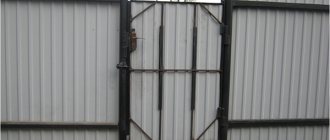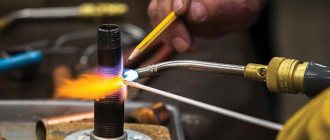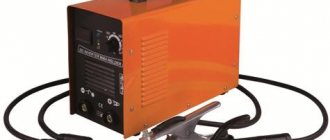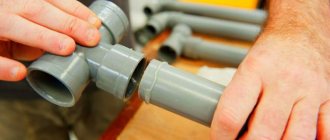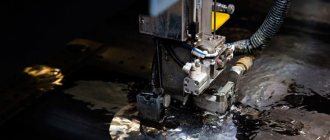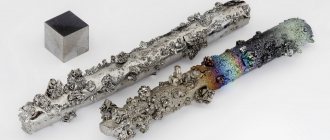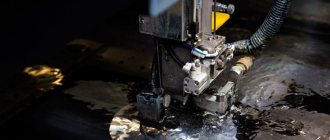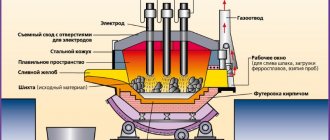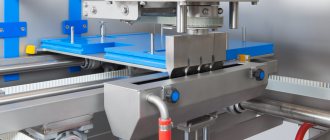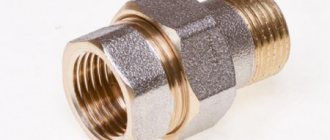What is an "inverter"?
" Inverter " refers to innovative welding devices. The principle of its operation is the ability to convert electric current supplied via alternating networks (the most common) into rectified direct current, and then alternating current with the required frequency, as well as a force sufficient to carry out high-quality welding. For this purpose, the built-in “inverter” rectifier is used.
Let us examine in more detail the principles of operation of the inverter unit.
After rectification, the current is smoothed out by a special filter, which is present in the design of the device in question. Afterwards, through special transistors, it is again converted into alternating, but with a very high frequency - several tens of kHz. For comparison: electric current travels through networks with a frequency of 50 Hz. The voltage of the high-frequency current in the “inverter” is reduced to approximately 70-90 V, while the current strength increases - to approximately 100-200 A.
This technology makes it possible to generate current for welding using devices with small dimensions, and, moreover, consuming relatively little electricity.
Modern inverter machines, as a rule, provide significantly higher quality welding than many other types of units. Moreover, according to some experts, “inverters” are more convenient to use than their analogues. These units are well suited for beginners with little experience and welders. Although, of course, the use of appropriate devices requires a fairly high level of professional training of the employee.
The welder receives a unit with relatively small dimensions and weight - about 4 kg. It is convenient to move it from one place to another, and to carry out welding in hard-to-reach areas of buildings.
Among the most remarkable properties of the welding machines in question is the ability to function even with a not very stable network, and, if necessary, to be powered by autonomous home power plants.
"Inverters" provide the most stable supply of welding current. The fact that there may be voltage fluctuations at the input does not matter. As a result, a sufficiently stable welding arc is formed. In addition, this welding technology significantly reduces the scattering of droplets of molten metal.
Among the disadvantages of “inverters”:
- high price;
- possibility of operational failures at temperatures below minus 15 degrees.
In addition, a feature of many inverter welding units is the need to use a power cable, the length of which does not exceed 2.5 meters.
How to make a choice
When choosing between a welding transformer or a welding inverter, you should pay attention to the positive and negative aspects of these types. They are not always obvious at first glance, especially to non-professionals.
We have already found out what these devices are in general terms. But which one is better to choose? Which one will be more suitable? It is impossible to give a definite answer for everyone. There are many aspects that we will tell you about.
Note that both of them are completely different. This is a difference in the internal “filling”, and in the operating mechanism, and in functional adjustments. They also differ in size and severity.
Beginners often find an inverter more convenient because it is equipped with additional functions that help in their work. But their power and reliability are sometimes inferior in performance.
The transformer is more difficult to use for beginners, but its power is higher and its capabilities are wider. But here everything will depend on experience and, developed in practice, the correct settings of the device.
Therefore, we can advise the purchase of a transformer to anyone who plans to seriously and regularly engage in welding without significant expenses for an inverter machine with the required power.
If you have limited financial resources, but still want to have a reliable welding machine, choose a transformer.
What is a "transformer"?
Transformer welding units operate on alternating current and generally do not straighten it before applying it to the electrode. This feature often determines the poor quality of seam formation during welding.
In order to optimize the work result, the welder can use an external rectifier. But you need to keep in mind that such a unit is not cheap: its price can be comparable to the cost of a “transformer”. In addition, installing a rectifier noticeably makes the welding system heavier, and therefore moving it from one place to another as easily and quickly as in the case of an “inverter” is not easy.
“Transformers” work without failures and provide good welding quality provided there is a stable supply of electricity. Not all types of transformer units function correctly when connected to the same autonomous power plants. Using a “transformer” requires a particularly highly qualified welder and significant experience working with this equipment.
The units under consideration do not always allow for smooth adjustment of the welding current supply. They are less economical than "inverters". Their weight is significantly greater than that of welding machines of the first type: it can be about 40 kg.
Among the undeniable advantages of the “transformer” is simplicity. This device functions by converting the current supplied to the transformer - primary - into secondary, characterized by a relatively low voltage and high current. In this case, the principle of electromagnetic induction is used. It involves the formation of a conversion coefficient due to the difference between the number of turns in different sections of the winding - primary and secondary.
Thus, the unit in question is very reliable and easy to install.
"Transformers" are relatively inexpensive. They are not characterized by strong sensitivity to frost - as is the case with “inverters”. Therefore, in many areas of application of welding machines, “transformers” are indispensable.
Welding process
The differences between an inverter and a welding machine during the welding process are as follows. The welding transformer provides an insufficiently stable electric arc. With small fluctuations in the network, the parameters of the welding current change. Inverters do not suffer from this, as they can maintain stability using various built-in circuits, which makes the work of welders easier. This also helps to avoid metal spattering during welding.
The inverter is more technologically advanced and has precise, smooth adjustment of parameters with a scale. The welding transformer has approximate settings and does not have an accurate scale. Modern inverters, even in their budget versions, have such functions as “Hot start”, “Anti-sticking”, as well as “Welding arc force”. The inverter is less energy-consuming and can be connected to a regular outlet, including autonomous power sources
Comparison
There is, of course, more than one difference between an “inverter” and a “transformer” in the context of welding technology. The difference between the types of aggregate under consideration is especially obvious when comparing them in terms of:
- current supplied to the electrode;
- electricity sources used;
- sizes;
- weight;
- welding quality;
- prices;
- frost resistance.
A small table will help us to more clearly reflect the difference between an “inverter” and a “transformer”.
Operating principle of a welding inverter
Serial production of welding inverters was established about 30 years ago. Their more accurate name is rectifiers with a transistor inverter. The main difference between welding machines of this type is the sequence of electric current transformations. In these devices, it has to change its characteristics several times. First, the current is rectified and becomes constant as it passes through the semiconductor. The next step is to pass it through a filter for additional smoothing. Then the current enters the inverter and is converted into alternating current with a frequency of about 100 kHz. After this, it enters a transformer, in which the voltage decreases and the current increases. It then goes into a high-pass filter and then into a rectifier. The output produces a direct current of the required parameters.
Due to such complex transformations, it was possible to reduce the dimensions of the welding machine. An example of such a device is ELITECH AIS 200 PNS.
This is what a welding inverter looks like
Table
| Inverter welding machines | Transformer welding machines |
| They operate by converting alternating current into direct current and then back into alternating current with high frequency and current strength. | Function by amplifying current using the principle of electromagnetic induction |
| It is assumed that the current is rectified before being supplied to the welding electrode. | For these purposes, they require the use of a rectifier - a rather expensive unit, which also noticeably makes the welding machine heavier. |
| They are small in size and weight | They usually have a significantly larger size and weight |
| In many cases allow for higher welding quality | They do not always provide welding quality comparable to that achieved with “inverters” |
| They cost more | They cost less |
| Less frost-resistant | More frost resistant |
Operating principle of a transformer welding machine
Modern transformer welding machines are reliable and unpretentious. They operate at a frequency of 50 Hz. Electric current is converted using a transformer. This happens as follows. First, a current of 220V is supplied to the primary winding of the transformer. It magnetizes the composite core, which creates an alternating magnetic field. As a result, an alternating current appears in the secondary winding, but its parameters are already different: voltage - 50-90V, current - 100-200A. The latter value directly depends on the number of turns in the secondary winding of the transformer. It is adjusted mechanically. An example of such a device is WESTER ARC 130.
This is what welding transformers look like
Electric welding was first used in practice by the Russian inventor N.N. Benardos in 1881.
Advantages of an inverter device
- The efficiency of the devices reaches 95%. Energy losses are minimal.
- The devices are characterized by increased electrical safety.
- They can be connected to a regular household network without consequences.
- The devices have a very wide range of current regulation. Thanks to this, it is possible to use different types of electrodes and select the required welding mode for metals.
- All operation of the devices is regulated by control circuits and microprocessors. This ensures easy ignition and stable arc retention.
- The voltage and current in inverter devices are adjusted smoothly.
- The devices are equipped with protection against surges in mains voltage.
- Welding can be carried out in any spatial position.
Which welding machine is better: inverter or transformer
Deciding what is best for welding metal in your own garage or home is not difficult. Comparative characteristics of power supplies will help. First, about the similarities: both are necessary for converting electric current, obtaining operating current parameters, only inverters are equipped with electronic converters.
A short example will help you compare the dimensions of inverter and transformer welding machines. To generate 160 A, you need a transformer weighing 20 kg or an inverter weighing 2.5 kg. The inverter has the highest power, however, transformers have high efficiency.
A transformer unit is more difficult to master; special knowledge and skills will be required to set it up. Inverter devices are easier for beginners. Reduces the risk of uneven seams due to built-in functions:
- Hotstart improves arc ignition when the welder is turned on;
- Arcforce prevents the electrode from sticking when a drop falls, forcing the electric arc;
- Anti-stick protects against overload during a short circuit, the arc does not go out.
The capabilities of the inverter are wider; you can obtain a constant electric current of the required strength. High-frequency or pulsed alternating is similar in action to constant.
Transformer welders do not have such a concept: intermittency; the operating mode is indicated on each inverter. If the efficiency is 50%, every half hour the unit is turned off for 15 minutes.
It is impossible to say unequivocally which welder is better. Or rather, such a conclusion makes no sense. Much depends on the working conditions, the nature of the workpieces being welded, and the skill of the welder, finally.
Inexpensive inverter devices are well suited for a summer house and garage, in cases where there is no extensive work experience and they are used a couple of times a year. But you should not forget about storage: protect from high humidity, dust and low temperatures.
What is an inverter?
The need for welding work arises not only in industrial activities, but also at home, in the domestic sphere. Often such work appears for owners of private houses or summer cottages. Thanks to the purchase of welding equipment, you can solve any current problem in a short time.
Before choosing a suitable design for your home, you need to understand its purpose, functions and important details of use.
A welding inverter is a device thanks to which you can carry out any welding work at large production enterprises or for private use.
A worthy choice should depend not only on price, capabilities, and quality of work performed, but also taking into account the technical characteristics of the equipment, conditions and specific nuances during operation.
Electrical circuit of a welding inverter.
Important criteria to note when selecting and purchasing inverter welding equipment are as follows:
- The company needs to check the availability of printed circuit boards suitable for a specific design model. They are quite fragile, and repairs are very expensive. In other words, if a specialist has a lot of them, this indicates that the mechanism will most likely break down frequently in the future. In the absence of spare parts and the possibility of purchasing them only for individual order, we can talk about the performance and longevity of the equipment. Additionally, it is recommended to clarify the cost of repairs and production of parts.
- Availability of built-in ventilation. The welding process produces a lot of dust, so it is very important that the design has a cooling fan with a direct purpose. In addition, it must suck up dust. Most manufacturers integrate tunnel ventilation. Thanks to this internal mechanism, additional protection of all main parts from dirt and dust is provided, but the cost increases significantly.
- Protection against sudden voltage changes must be installed. Most welding inverters are sensitive to voltage surges due to built-in protective mechanisms that begin to work when there is a surge of 220 V.
By ensuring that the buyer gets enough information and is able to understand the differences between an inverter and a transformer, the process and task will be successfully completed without any difficulties.
The acquired knowledge will help not only specialists, but also beginners who do not understand the specifics of the instrument. The level of performance depends on the set temperature. It is this that affects the quality of functionality.
For example, due to high temperature - 40+, additional protection mechanisms may start working. However, such an indicator is quite rare in practice. With low temperatures the opposite is true.
Almost every modern equipment contains capacitors, microcontrollers, transistors, etc., which have an individual temperature range.
In cold weather, care must be taken to avoid condensation. At zero temperature, the device may simply not turn on, this will be indicated by a red light with an overload indicator.
When choosing this equipment, you need to familiarize yourself with the passport, operating conditions, permissible temperature, and also find out the possibility of repair services, warranty and the availability of the official website and detailed instructions for use from the manufacturer.
What is the difference between a welding machine and an inverter?
If you need to carry out welding work yourself, the question arises: what type of welding machine to purchase. Welding is the creation of permanent connections between welded parts at the atomic level. The welded connection is one of the strongest and therefore is used quite often.
During electric welding, heating and melting of the metal occurs due to the formation of an electric arc between the end part of the electrode and the surface to be welded. Sources of arc formation and maintenance are divided into several types:
- Transformer.
- Inverter.
- Rectifiers.
- Welding units based on internal combustion engines.
Let's consider two types that are most widely used: a welding machine based on a transformer and an inverter source of electric arc.
Which is better: a welding transformer or an inverter. What is the difference
Welding inverter "Elitech IS 220".
As can be seen from the table, both gadgets have their pros and cons.
Welding with a transformer is much more difficult than with an inverter.
Let's say more: if you learn to cook with a transformer, you can easily “switch” to an inverter.
But if it’s the other way around, it won’t be so easy.
If the budget is not limited, then, of course, an inverter. The difference between a transformer and an inverter, we will consider different options in further discussions.
For the dacha
At the dacha there is a lot of work for a welder:
- a “stable” for your “steel horse” is a garage;
- greenhouses and everything connected with them;
- garden watering system;
- Summer shower;
- repair of country equipment, etc.
Note that dachas appeared long before the invention of inverters, and everyone made do with transformers. Many people still use them now. But with an inverter, welding is easier, faster, and of better quality.
For home
In a house, especially a private one, there are no fewer problems than in a country house. But if at the dacha you can take some welding “liberties with unsightly” welding, then at home this will be unforgivable. Therefore, the house must have an inverter.
For garage
In a “men’s club” (some call this establishment a “garage”, although they don’t even have a personal car), a welding machine can have a very wide field of application: from minor repairs (the carrying handle has fallen off) to car body repair. And if the owner of the gadget is a “jack of all trades,” then, of course, he needs an inverter.
For the forge
“Serious men” with large metal parts work here. They need a powerful transformer more. With a certain skill, they will use it to perform all the necessary operations.
For installation of forged products
For the installation of forged products, especially those produced by the “cold forging” method, only an inverter is needed. It will allow you to avoid overheating, sticking, etc. welding defects. This will preserve the artistic value of these forged products.
For car service
It is advisable to use an inverter at a car service center. For body work, there is an automatic welding machine with an inverter source of welding current.
For production
In production, the type of welding equipment prescribed by the technological process should be used. In heavy engineering, a transformer may be used, but in precision engineering - only an inverter current source.
For the construction of a private house
At the construction site of a private house, you can use a transformer to weld reinforcement – it will perfectly “connect” it. Yes, and other welding can be done on it.
For a professional builder or construction company
For construction professionals, of course, only an inverter is needed: it will provide high-quality welding and high productivity. Its cost will “dissolve” in the overhead costs of equipment.
